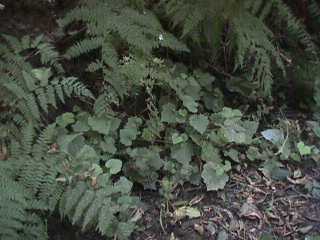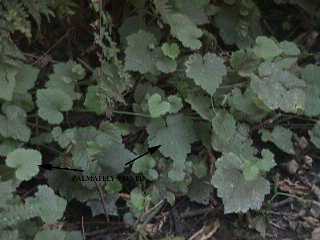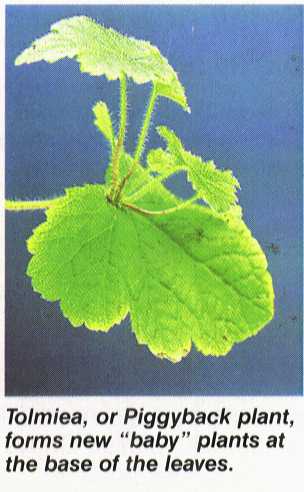


General Species Description
- The piggyback plant is a hairy, rhizomatous, perennial herb. Flower stems emerge from a basal grouping of leaves, grow to eighty centimeters tall, and are covered with glands in addition to being hairy. This anomalous saxifrage has several quaint names referring to its way of producing aerial offset plants from its leaf axils.
Leaves
- The leaves in the piggyback plant are palmately veined, ten centimeters wide, eight centimeters long with margins once or twice shallowly toothed. They are borne on long (seven to twenty centimeter) stalks. Plants reproduce by developing buds at base of the leaf blade where the leaf stalk emerges.
Inflorescence/Flowers
- The piggyback plant is a terminal, spike-like cluster bearing tube-shaped flowers. Flowers are green-purple to chocolate-colored, medium sized (nine to fourteen millimeters long) with four petals and three stamens. Blooms from May through August.
Fruits
- The piggyback has fruits with a two-beaked capsule longer than the sepals.
Habitat
- The piggyback plant is found in moist dark woods, especially on the muddy banks of shallow streams.
Range
- These plants can be found from Southern Alaska along the west coast to Santa Cruz, California. Found only rarely east of the Cascades. Occurs in all counties in our area.
Similar Species
- The three-lear foamflower (Tiarella trifoliata) has a similar basal growth form, bright green leaves and terminal spike-like flower cluster, but leaves are compound with three leaflets and flowers are minute and white. White fringecup (Tellima grandiflora) has similar basal, bright green, lobed leaves and erect terminal spikes, the leaves are round, flowers are yellow-green (Sometimes pinkish) large (Six to Eight millimeters) cup-shaped with lace-like petals that curve backwards, and it grows in drier areas.
Ecological Value
- Stabilizes soil near a stream, and provides hiding places and nesting sites for birds and small mammals.
Human Value
- The piggyback plant adds aesthetic appeal to perennial gardens in moist conditions while also being used for inside as a cherished house-plant
References
- Cooke, S. S. ed. 1997. A Field Guide to the Common Wetland Plants of Western Washington and Northwest Oregon. Seattle Audubon Society and Washington Native Plant Society. Seattle Audubon Society, Seattle, WA. 204 pp. Hitchcock, C. L. and A. Cronquist. 1973. Flora of the Pacific Northwest. University of Washington Press, Seattle, WA. 199 pp. Mathews. 1994. Cascade Olympic Natural History. Ravens Editions. 198 pp.
This page was created by: Laura Nash, August 1998
Return to Northwest Oregon Wetland Plants Project